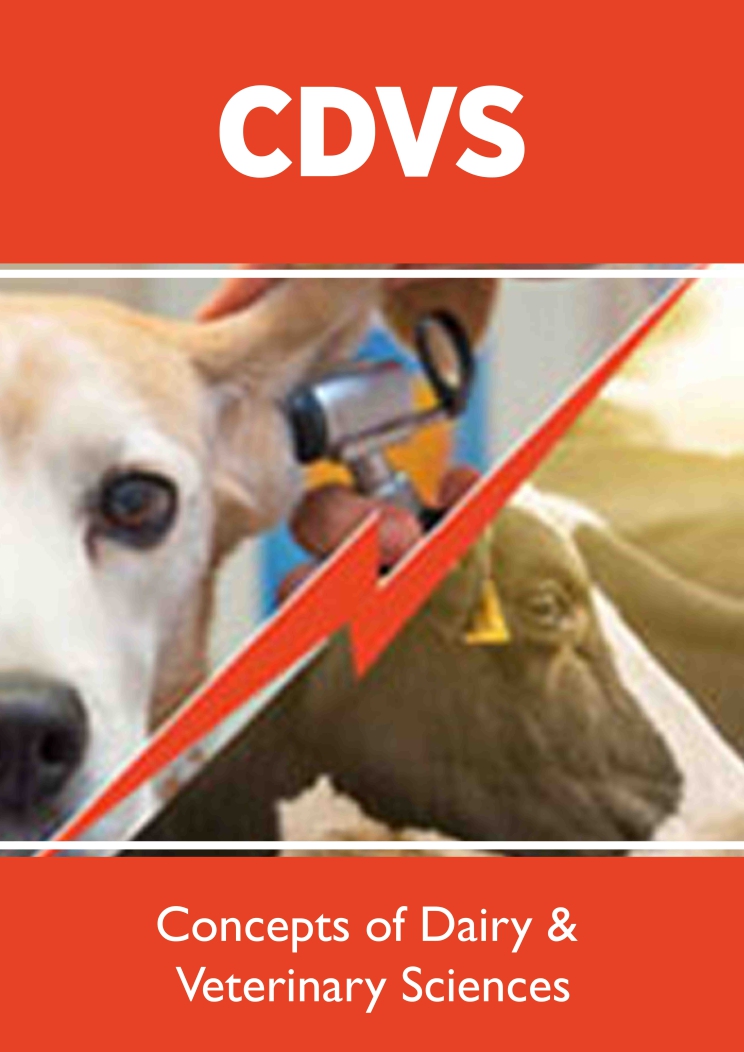
Lupine Publishers Group
Lupine Publishers
Menu
ISSN: 2637-4749
Research Article(ISSN: 2637-4749) 
Cross Sectional Economic Loss Analysis Study on Bovine Viral Diarrhea Infection in Dairy Holders of Tamil Nadu Volume 5 - Issue 5
Krishna Kumar1*, KM Palanivel, G Ponnudurai, K Sukumar, B Samuel Masilamoni Ronald, G Selvaraju
- 1Associate Professor and Head, Department of Veterinary Public Health and Epidemiology, Veterinary College and Research Institute, Udumalpet, Tamil Nadu, India
Received: June 20, 2024; Published: July 09, 2024
Corresponding author: S Krishna Kumar, Associate Professor and Head, Department of Veterinary Public Health and Epidemiology, Veterinary College and Research Institute, Udumalpet, Tamil Nadu, India
DOI: 10.32474/CDVS.2024.05.000223
Abstract
Estimation of economical loss in Bovine viral diarrhea in cattle of Tamil Nadu was inaccessible. A standardized module was formulated and used to calculate the economic loss in bovine viral diarrhea infection in dairy cattle. This study included the population at risk, sera prevalence, clinical case categorization and system wise loss. Using field real-time financial values, a spreadsheet model was constructed. Concurrent infection of Tuberculosis, Infectious bovine rhino tracheitis and brucellosis in bovine viral diarrhea sera positive animals were recorded in terms of loss. We concluded that the modules represent a useful start in developing a system for the comparative economic loss assessment of livestock diseases in Tamil Nadu.
Keywords: Bovine vial diarrhea; Cattle; Economic loss; Tamil Nadu
Results
Dairying, as an economic activity provides regular income to millions of rural families in Tamil Nadu throughout the year. The 2005-06 milk production of Tamil Nadu was 54.74 lakh MT has increased to 71.32 lakh MT in 2014-15 [1] Apart from the endemic diseases of livestock in Tamil Nadu, some of the emerging disease like Bovine viral diarrhea (BVD) pose a threat to livestock sector. Bovine viral diarrhea is an economically important disease of dairy cattle all over the world caused by Pest virus grouped under Flaviviridae family. Bovine viral diarrhea virus also causes immunosuppression which can render infected animals more susceptible to other bacterial and viral infections [2]. Clinical manifestation in BVD 1a affected cattle who had diarrhea, respiratory disorders like pneumonia, abortion, poor conception, weak calf, mouth ulcer and non-specific fever [3]. Serum samples were used to detect BVDV antibody level in dairy cattle to find the actual prevalence status in the population of Tamil Nadu and Maharashtra [4,5]. The losses due to various forms of BVDV infection includes reduced milk production, poor conception rate, respiratory disorders, death among animals acquiring acute infection, abortions, congenital defects and growth retardation after fetal infection [6]. Detailed reports on actual epidemiology and economic loss due to bovine viral diarrhea on the small dairy holder of Tamil Nadu is lacking. Assessing the seroprevalence of a viral disease and assessing the losses due to the illness caused by BVD infection plays a major role to frame the policy note to control the disease. Hence it was planned to work on epidemiology and estimation of economical loss of bovine viral diarrhea in cattle of Tamil Nadu.
Materials and Methods
Source of clinical samples
A total of each 500 sera and whole blood in EDTA tubes, 52 dung samples, 39 nasal swabs, 53 milk samples, 6 tissue samples and 27 semen samples were collected from 62 organized dairy farms located in north western zone of Tamil Nadu includes Coimbatore, Erode, Tirupur and Karur districts for assessing the prevalence and detection of bovine viral diarrhea virus (BVDV) infection in the study population and transported to laboratory on ice as per the procedure described in OIE,2015. All the dairy animals were not immunized for BVD till then. The present research on epidemiology and economic loss due to bovine viral diarrhea on the small dairy holder of Tamil Nadu, India. As per the AEU model, each category of livestock (sheep, goat, buffalo, horse, calf and birds) was converted into cattle unit and mean of the study population was divided into three as small, medium and farm [7].
Assessing the economic losses caused by BVD infection
The ex-post losses (direct loss and treatment cost) of the disease at the regional level were assessed using a partial budget model adapted from a spreadsheet method [8,9]. Cost incurred towards treatment, medicine, feed, labor and cost of animals were collected from farmers as real time data to ensure high accuracy.
Assessing the economic losses in concurrent infection with BVD seroprevalence
Mortality from BVD, although low in dairy farms, would invite other infection mainly because of immunosuppressive nature of the BVDV. Details of concurrent infections were collected from farmers who used to screen their farm animals regularly for important infectious diseases like Tuberculosis, Brucellosis and Infectious bovine rhino tracheitis (IBR).
Results
Out of 62 dairy farms screened 17 were found to be positive for BVD antibodies. Among the four districts, nine out of 14 dairy farms from Coimbatore district were positive with percent positivity of 64.28 and stands first followed by Tirupur district was 33.33, 10.52 in Erode district and 7.14 in Karur district (Table-3). Out of 500 sera samples screened, 66 samples were positive for BVD antibodies by indirect ELISA with a per cent positivity of 13.20. (Table 1). The seroprevalence of BVD was found to be 32.00, 5.60, 2.40 and 12.80 per cent in Coimbatore, Erode, Karur and Tirupur districts respectively. Herd level seropositivity was recorded as 27.14 percent in the study area (17/62).
<Assessing the economic losses in BVD seropositive dairy farm
Economic loss due to BVD infection was calculated as partial budget model by calculating direct and indirect losses. Direct loss includes animal value, medicine and treatment cost and indirect costs includes loss in milk yield, extra labor and feed cost (Table 2). One of the major outcomes of BVD was abortion which leads to animal infertility and sometimes sterility. The loss incurred towards abortion was INR.5,810.00. In that, INR 2,800.00 (48.2%), INR 1450.00 (24.6 %), INR 910.00 (15.7%) and INR 650.00 (11.1%) were calculated for cost of calf, treatment cost, loss in milk yield and extra labor with feed cost respectively (Table 3). Repeat breeder is another consequence of BVD infection which was a reason where farmers failed to get a calf per year. The loss due to repeat breeder was calculated as INR 4,575. This included treatment cost, cost for extra feed with labor cost and loss in milk yield as INR 1,850.00 (40.4%), INR 480.00 (10.4%) and INR 2,245.00 (49.1%) respectively (Table 3).
The incidence of clinical mastitis was higher in BVD sera positive farms than BVD sera negative farms. The economic loss towards mastitis was calculated at the tune of INR.2,805.00. This cost included treatment cost, loss in reduction in milk yield and extra labor with cost incurred towards biosecurity for about INR 1,350.00 (50%), INR 980.00 (33.3%) and INR 475.00 (16.7%) respectively (Table 3). The BVDV affects respiratory and gastrointestinal tract and causes pneumonia and enteritis, and the loss was calculated as INR.680.00 and INR.740.00 respectively. The economic loss due to BVD in small, medium and large farms was INR 4,209.00, INR 6,480.00 and INR 1,02,748.00 respectively per year (Table 4). Economic loss towards abortion, repeater, enteritis, mastitis and pneumonia were INR 84,18,0600.00, INR 13,64,03,750.00, INR 16,83,6,120.00, INR 87,92,1,960.00 and INR 16,83,6,120.00 respectively.
Table 4: Assessing the economic loss in BVD positive farms with respect to illness in northwestern zone of Tamil Nadu. Values in parenthesis indicate the average number of animals per farm.

Assessing the economic losses due to concurrent infection in BVD seropositive dairy farm
Immunosuppressive character of BVDV, especially invites the commensal and opportunistic diseases like Tuberculosis, Brucellosis and Infectious bovine rhino tracheitis (Table 5) This concurrent infection would causes severe economic loss in the dairy farm.
Direct economic loss due to loss of milk yield will costs at the tune of INR 350, INR 220.00, INR 180.00 and INR 120.00 by BVD, IBR, Tuberculosis (TB) and Brucellosis respectively. The economic loss due to premature or because of reduced culling rate was calculated as INR 2,580.00, INR 2,489.00, and INR 2,478.00 by BVD, IBR and Brucellosis respectively. Abortion caused loss at the tune of INR 1,250.00, INR 1,240.00, and INR 1,650.00 by BVD, IBR and Brucellosis respectively (Table 6) Indirect loss includes veterinary services for BVD, IBR, TB and Brucellosis incurred at the tune of 1 INR 113.00, INR 874.00, INR 526.00 and INR 456.00 respectively. Medicine costs for treatment of BVD, IBR, TB and Brucellosis and their allied illness would cost INR 1,258.00, INR 450.00, INR 251.00 and INR 356.00 respectively. Extra labor costs for BVD, IBR, TB and Brucellosis infection were INR 345.00, INR 255.00, INR 245.00 and INR 317.00 respectively (Table 6). Total economic loss calculated for BVD with concurrent infection, IBR, TB and Brucellosis was INR 6,896.00, INR 5,528.00, 1,202.00 and INR 5,377.00 respectively.
Table 5: Concurrent infection of IBR, Brucellosis and Tuberculosis in BVD seropositive dairy cattle of northwestern zone of Tamil Nadu.

Table 6: Assessing the economic loss in BVD in association with concurrent infection of dairy cattle in northwestern zone of Tamil Nadu per year / farm.

Discussion
The present seroprevalence of BVD in dairy cattle of northwestern zone of Tamil Nadu was 13.20 per cent during the study period. 13.82 per cent in dairy cattle and 12.5 per cent in buffalo in organized and unorganized dairy farms were seropositive for BVD in Uttar Pradesh [10]. Tamil Nadu was recorded seropositivity at the tune of 17.30 per cent [4]. However, higher seroprevalence of 24.71 per cent in Kerala [51] and 27.4 per cent [11] were reported in Tamil Nadu. The variation in the seropositivity depends upon the size of study population and sampling methods. Bovine viral diarrhea is a devastating important viral disease in dairy cattle, sheep, goat, pig and wildlife species and responsible for significant economic loss in all phases of dairy industry from reproduction, respiratory and gastrointestinal infection [12]. Thus, BVDV will mainly affect the reproductive, respiratory and mammary glands which leads to infertility, pneumonia and mastitis respectively. Hence the study concentrated on repeater, abortion, feed cost, additional labor, milk loss, medicine cost, enteritis and their incidence rate.
Based on the spread sheet model, the data were collected in real time from farmers and calculated for cost of animals, production parameters, cost of treatment and incidence rate and the same is presented. The loss incurred by BVD in dairy cattle was estimated to be INR.5,810.00, INR.4,757.00 and INR.2,805.00 towards loss in abortion, repeat breeder and mastitis respectively. As the study population were divided into small, medium and large farms for the convenience to assess the comparative economic loss among them. The overall economic losses in BVD seropositive farms associated with risk factors in north western zone of Tamil Nadu were INR.4,209, INR.6,408 and INR.1,02,748 in small, medium and large farms respectively which is in correspondence with the findings [9] who reported that 50.0, 25.0,16.7 and 8.3 per cent were due to treatment cost, loss in milk yield, extra labor and feed cost to BVD infected farms respectively. Further he also estimated the economic losses from BVD outbreak which was in the range of INR.2676.00 to INR.6356.00 per cow. There are no reports available on the recorded economic losses of BVD in different locations of Tamil Nadu as well as in India to substantiate this claim. The variation in economic loss in small, medium and large farms might be due to diverse risk factors, farm size, poor nutrition and immunosuppressive effect which may contribute to the variant economic losses in dairy cattle in this region. The level of economic loss had seemed to be lower in small and medium farms which had an average animal holding capacity between 8 to 23. These farmers used to purchase new animals rarely and the chances of introduction infected animals into their farms was very remote. Moreover, these category farmers were more of personal usage of the livestock products in terms of milk, calf, manure rather than purely commercial in nature. A lower farm size also having selfclearance phenomenon where BVDV rate will be vanished over the period where there is poor /low introduction of new animals [13]. Higher stock strength automatically attracts more infection rates because of proximity of infected and healthy animals, manure disposal interval, introduction new animal to maintain the milk production to sustain in the dairy market. Larger herd farmers were forced to have commercial formulas to sustain their business in the dairy industry. Frequent culling of repeater, treatment cost for mastitis, purchase of new animal in a higher cost will all packs to rise of economic loss by BVD infection.
Economic losses were attributed when seroprevalence reaches 45 per cent [6]. But this study recorded lower seroprevalence (13.20%), but economic loss was observed. This is because of the presence of a greater number of persistently infected (PI) animals in the seropositive herds. Based on the prevalence rate, an attempt was made to estimate the economic losses due to BVD in northwestern zone of Tamil Nadu in the study period.
The economic losses by an animal for a year due to BVD in association with concurrent infection of dairy cattle of northwestern of Tamil Nadu was INR. 6896.00, whereas a sum of INR.5,528.00, INR.1,202.00 and INR.5,377.00 were recorded in IBR, TB and Brucellosis respectively. The economic loss of BVD with concurrent infection was higher in dairy cattle when compared to other individual infections in northwestern zone of Tamil Nadu during the study period. This is since BVD infection combined with other infectious agents could cause much higher losses than dairy animals free from BVD [6]. Further he also estimated economic losses due to concurrent infection of IBR, TB, Brucellosis and Leptospira and rickettsial infection in dairy farms could cause a total of INR.50,820.00 /farm/year.
Conclusion
The present study has identified the BVD seropositivity of 13.20 per cent in northwestern zone of Tamil Nadu. Economic loss was assessed in BVD seropositive farms by spread sheet method and found to be INR. 4290, INR.6480 and INR.102748 in small, medium and large farms respectively per year. In this study experienced that the total loss was estimated in dairy cattle by BVD with concurrent infection with IBR, TB and Brucellosis was INR.6896, INR.5528, INR.1202 and INR.5377 respectively per year at farm level. Economic losses towards abortion, repeater, enteritis, mastitis and pneumonia were INR.8,41,80600, INR.13,64,03,750, INR. 6,83,6,120, INR.87,92,1,960 and INR.16,83,6,120 respectively.
Conflict of Interest Statement
The authors declared that they have no conflict of interest.
Acknowledgement
The authors expressed their sincere thanks to Tamil Nadu Veterinary and Animal Sciences University, Chennai -51, Tamil Nadu, India.
References
- (2015) Tamil Nadu Animal husbandry policy note pp: 13-15.
- Neibergs JS, Zanella R, Casas E, Snowder GD, Wenz J, D Moore (2011) Loci on Bos taurus chromosome 2 and Bos taurus chromosome 26 are linked with bovine respiratory disease and associated with persistent infection of bovine viral diarrhea virus. Journal of Animal Sciences, 89(4): 907-915.
- Tajima M, EJ Dubovi (2005) Genetic and clinical analyses of bovine viral diarrhea virus isolate from dairy operations in the United States of America. J Vet Diagn Invest 17(1): 10-15.
- Sudharshana KJ, KB Suresh, M Rajasekhar (1999) Prevalence of ovine viral diarrhea virus antibodies in India. Rev sci tech Off int Epiz 18(3): 667-671.
- Vinodkumar KA, N Joseph, N Thrithamarassery, S Asok, K Latheef, et al., (2015) Epidemiology of bovine viral diarrhea among tropical small holder dairy units in Kerala, India. Trop Anim Health Prod 47(3): 575–579.
- Houe H (1999) Epidemiological features and economical importance of bovine virus diarrhea virus (BVDV) infections. Vet Microbiol 64(2-3): 89-107.
- USDA (1997) Natural Resources Conservation Service. National Range and Pasture Handbook.
- Bennett RM, K Chirstiansen, RS Clifton-Hadley (1999) Preliminary estimates of the direct costs associated with endemic diseases of livestock in Great Britain. Prev Vet Med 39(3): 155-157.
- Weersink A, A John, V Leeuwenb, J Chia and GP Keefeb, et al., (2002) Direct production losses and treatment costs due to four dairy cattle diseases. Adv Dairy Tech 14: 55-75.
- Varshney P, AK Bhatia, H Pradhan, N Mishra and S Bhatia, et al., (2009) Seroprevalence of bovine viral diarrhea virus antibodies in cattle and buffalo of Agra region of Uttar Pradesh (India). J Immunol Immunopathology 11(2): 39-42.
- Selvaraj J, B MuraliManohar, C Balachandran, N Mishra and HK Pradhan, et al., (2007) Seroprevalence of bovine viral diarrhea in buffaloes at Chennai. Indian J Vet Pathol 31: 180.
- Radostits OM, CC Gay, C Douglas Blood, W Hinchcliff (2003) Viral diseases characterized by alimentary tract signs, In: Veterinary Medicine: a textbook of the Diseases of cattle, Horses, Sheep, Pigs and Goats, 9th edn. WB Saunders Co UK pp: 1085-1095.
- Kampa J, S Alenius, U Emanuelson, A Chanlun and S Aiumlamai, et al., (2009) Bovine herpesvirus type 1 (BHV-1) and bovine viral diarrhea virus (BVDV) infections in dairy herds: self-clearance and the detection of seroconversions against a new atypical potyvirus. The Vet J 182(2): 223-230.

Top Editors
-

Mark E Smith
Bio chemistry
University of Texas Medical Branch, USA -

Lawrence A Presley
Department of Criminal Justice
Liberty University, USA -

Thomas W Miller
Department of Psychiatry
University of Kentucky, USA -

Gjumrakch Aliev
Department of Medicine
Gally International Biomedical Research & Consulting LLC, USA -

Christopher Bryant
Department of Urbanisation and Agricultural
Montreal university, USA -

Robert William Frare
Oral & Maxillofacial Pathology
New York University, USA -

Rudolph Modesto Navari
Gastroenterology and Hepatology
University of Alabama, UK -

Andrew Hague
Department of Medicine
Universities of Bradford, UK -

George Gregory Buttigieg
Maltese College of Obstetrics and Gynaecology, Europe -

Chen-Hsiung Yeh
Oncology
Circulogene Theranostics, England -
.png)
Emilio Bucio-Carrillo
Radiation Chemistry
National University of Mexico, USA -
.jpg)
Casey J Grenier
Analytical Chemistry
Wentworth Institute of Technology, USA -
Hany Atalah
Minimally Invasive Surgery
Mercer University school of Medicine, USA -

Abu-Hussein Muhamad
Pediatric Dentistry
University of Athens , Greece

The annual scholar awards from Lupine Publishers honor a selected number Read More...







